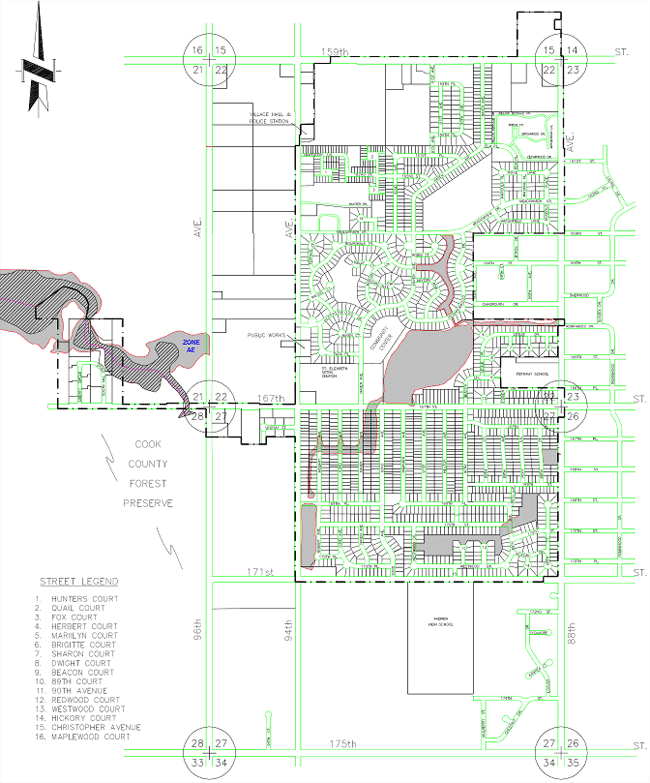Orland Hills' drainage system is subject to three flood problems: yard drainage problems, underdesigned or obstructed storm sewers, and overbank flooding from Tinley Creek and certain detention areas. This article reviews these problems and what the Village is doing about them.
Yard drainage: When an area is laid out for development, strips along the lot lines are set aside to carry water. Usually a five or ten foot easement is established. When the lot is built on, there should be no construction in this easement.
Filling on the lot should slope to the easement so drainage will run away from the building. A shallow depression or swale is kept along the lot lines. The swale guides stormwater runoff to the front or back yards where it is sent to the street or storm sewer. Downspouts and sump pump discharge pipes should point to the swale so excess water is drained properly.
Over the years, this yard drainage system has been disrupted. Many property owners are not aware of the need to keep their easements and swales open. They installed sheds, planters, railroad ties or swimming pools in the easements. They built fences right on their lot lines to enclose the largest part of their properties. As a result, the water stands in the yards because it cannot go anywhere. Eventually it percolates into the ground.
Storm sewers: Storm sewers have been installed in some areas of town to augment the drainage system. Inlets collect water in the streets or gutters. Stormwater flows through the pipe to a larger sewer or a body of water.
When storm sewers work, the streets and yards are drained quickly. Storm sewers won't work if they are underdesigned or when they are blocked. Blockages can be caused by debris in the inlet, an outlet or outfall that is underwater, a broken pipe, or debris or sediment in the pipe.
Overbank flooding: The swales, streets and storm sewers carry the water to basins or to Tinley Creek. When these become overloaded, water leaves their banks and flood neighboring properties The overbank flood problems areas are shown on the map. The Village's largest problem is flooding from Tinley Creek.
Sometimes, the result of flooding is a nuisance, such as wet streets or a soaked backyard. However, either shallow water on the surface or saturated ground can cause flooding several feet deep on a floor that is below grade. Some houses in Orland Hills do not have finished basements because of chronic flooding. Dangers. Most flooding in Orland Hills is slow moving and shallow. However, this does not mean that floodwaters are safe. A car will float in less than 2 feet of moving water and can be swept downstream into deeper waters. This is one reason floods kill more people trapped in vehicles than anywhere else.
Dangers. Most flooding in Orland Hills is slow moving and shallow. However, this does not mean that floodwaters are safe. A car will float in less than 2 feet of moving water and can be swept downstream into deeper waters. This is one reason floods kill more people trapped in vehicles than anywhere else.

Natural and beneficial functions: Floodplains serve many functions besides carrying or storing floodwaters. They provide habitat for flora and fauna, groundwater recharge, and recreational and aesthetic opportunities. For example, Lake Lorin is a key recreational and cultural facility for the Village.
Lake Lorin also has some wetlands. Wetlands provide habitat for species that cannot live or breed anywhere else. They reduce flood velocities and erosion. Wetland vegetation filters water, making it cleaner for those downstream.
These wetlands are currently vacant and need to be preserved so they can continue to provide their beneficial functions. The Village and the Corps of Engineers will do their part by restricting construction in these areas. You can do your part by reporting filling, dumping and other alterations of these areas to the Building Department. Also, keep our storm sewers clean. Dumping anti-freeze, paint, and other chemicals in the storm sewers is the same as dumping poison into our streams and Lake Lorin. Adopt a storm sewer inlet and help keep it free of debris and pollutants.
If you see dumping, building or filling without a Village permit sign posted, contact the Building Department at 349-6666. The project may increase flooding on your property.
More information on flooding can be found on the FEMA Website: http://www.fema.gov/hazard/flood/info.shtm
